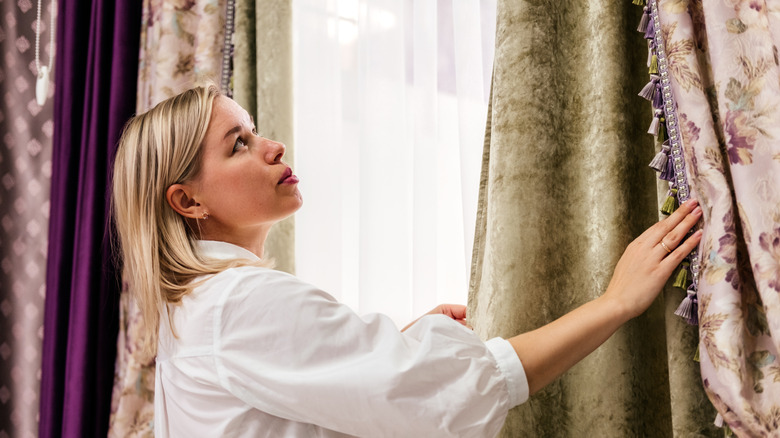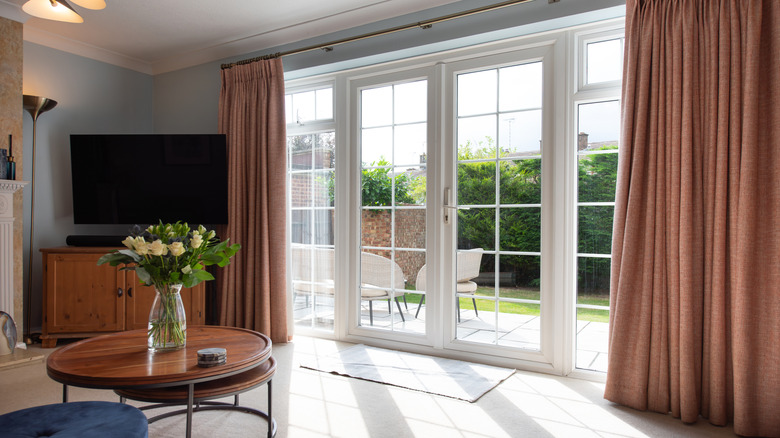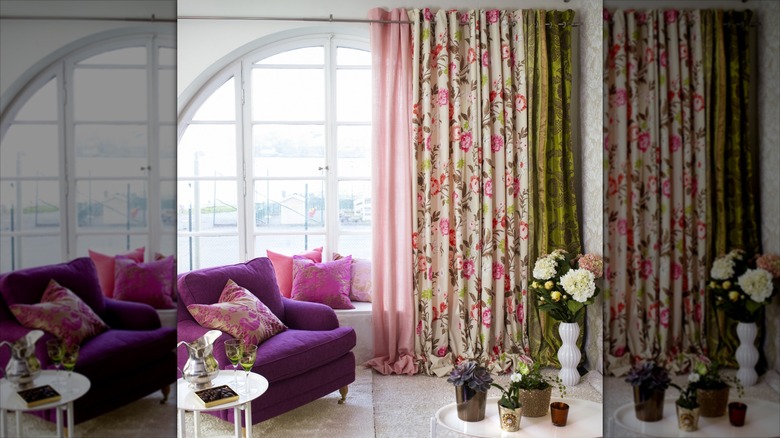How To Choose Between Plain Or Patterned Curtains For Your Space
We may receive a commission on purchases made from links.
Selecting a curtain material is one thing, but narrowing down the design choices? That's a whole other saga. Today's topic is the case of plain versus patterned curtains. On one hand, plain curtains can be treated like a blank canvas. These guys sit subtly in the background, ready to complement ever-changing décor styles. But then again, they can get a bit boring to look at day after day. On the other hand, patterned drapes add instant personality into a decorating scheme and zhuzh up a room with their eye-catching designs. This also means once you pick a pattern, there's no going back.
It was clear we needed expert insight. And so we tapped Jennifer Jones, principal designer at Niche Interiors, to get her professional advice. Speaking exclusively to House Digest, she said, "First, consider the upholstery and rug patterns already in your room." Let's take the living room as an example. You might have a neutral sofa and an area rug with loud motifs. Or maybe your armchair is wrapped in a printed fabric. "A good rule of thumb is to avoid patterns on every large item in a room, and instead mix in plain, solid fabric on some pieces to prevent the room from feeling too busy," Jones revealed. Once you have a better sense of the interior's ambiance, it's time to decide whether plain or patterned curtains best fit the vibe.
Plain curtains: the versatile and timeless choice
By plain curtains, we mean those in solid hues. You can find these in virtually every color of the rainbow — although neutrals definitely make the best bedroom curtain colors. "Plain curtains in light neutral tones give a room a feeling of lightness and restrained elegance, especially when paired with the right hardware," Jennifer Jones explained in her exclusive chat with House Digest. Think cream panels with bronze rods or perhaps a warm, tan fabric with silver hardware. Alternatively, you can go bold with colors like burgundy or forest green to make a statement with your curtains without visually overloading the space.
"A major benefit to using plain curtains is their longevity," the design expert told us. "Solid curtains can easily be mixed with any pattern and decorating style, avoiding the need to replace your window treatments often." For instance, while forest green curtains look striking against a white backdrop, they also pair seamlessly with gray, brick, and botanical-themed walls. Jones goes on to note that plain curtains have a rather clean, contemporary look, which in our opinion, never goes out of style. The NICETOWN Natural Linen Curtains is a great example, plus it comes in 15 chic colorways, from blush pink to caramel.
Patterned curtains: a fun and playful alternative
As Jennifer Jones said in her exclusive interview with House Digest, patterned curtains are more specific in style and color. Those with floral drawings typically give off a vintage feel, whereas geometric ones tend to lean more modern and eclectic. You might also notice that curtains adorned in tribal-style patterns (such as the ColorBird Curtains with Tasseled Sides) have a bohemian flair. Meanwhile, soft plaid window coverings are the epitome of traditional charm. It's just a matter of finding a design that complements your décor scheme.
"Patterned curtains add interest and depth to a room, creating a more layered and collected feel," the interior designer shared. But they can be tricky to work with. Not sure how to pull off the patterned look? Choose something that stands out and build upon that. Or, if you don't want your curtains to be overpowering, simply have them echo your existing color palette. According to Jones, the main drawback of patterned curtains is that you run the risk of getting tired of the specific design. To prevent that, consider mixing your curtain styles and swapping them over every now and then to boredom-proof your home.


